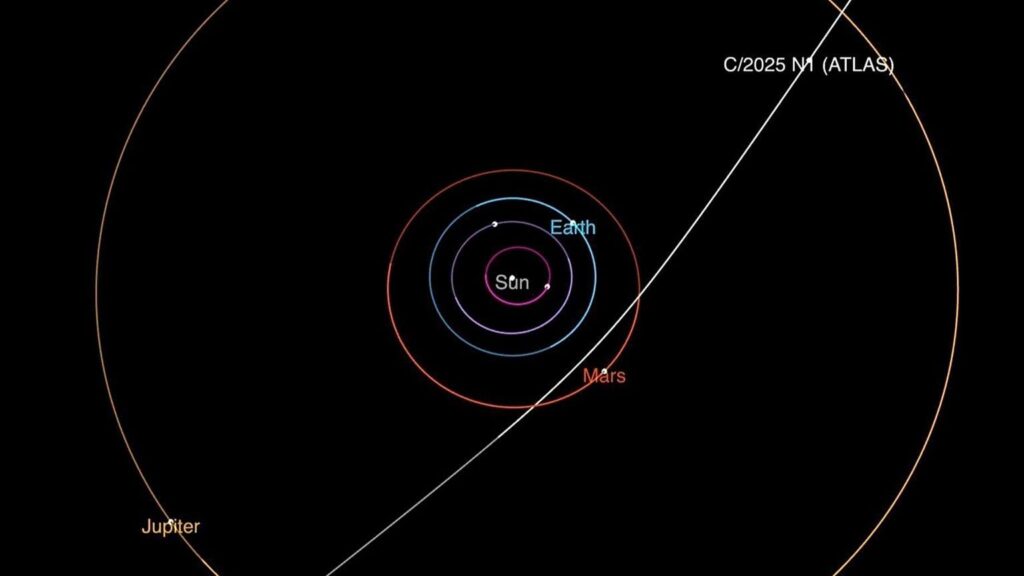Astronomers have unveiled the first detailed observations of Comet 3I/ATLAS as it reemerged from behind the sun, providing a rare glimpse into the behavior of this interstellar visitor. After weeks of obscuration by solar glare, the comet’s return has sparked excitement within the scientific community, offering new insights into its composition and trajectory. This milestone moment, reported by Live Science, marks a significant step in understanding one of the few known objects originating from beyond our solar system.
Astronomer Shares First Glimpse of Comet 3I ATLAS Emerging from Solar Obscurity
After weeks of being hidden in the sun’s blinding glare, Comet 3I/ATLAS has finally been captured on camera by astronomers, offering a rare and thrilling perspective on this interstellar wanderer. Emerging from behind the solar obscurity, the comet displays a brightening nucleus and a faint tail that promises intriguing observations as it journeys further into our cosmic neighborhood. This early glimpse not only allows researchers to confirm its trajectory but also provides vital data on its composition and activity, sparking excitement within the astronomical community.
Key observations noted by the lead astronomer include:
- Improved visibility: The comet’s brightness has increased steadily now that it is no longer blotted out by solar interference.
- Tail formation: Initial signs of gas and dust emission hint at the comet’s volatile materials reacting to solar radiation.
- Interstellar origin clues: Spectral analysis is underway to uncover the unique chemical signatures that set 3I/ATLAS apart from native solar system bodies.
| Parameter | Current Status |
|---|---|
| Distance from Earth | 1.2 AU |
| Brightness (Magnitude) | +7.5 |
| Tail Length | ~10,000 km |
Detailed Analysis Unveils Unique Features and Trajectory of Interstellar Visitor
Recent observations have provided unprecedented insights into Comet 3I/ATLAS, revealing a combination of physical traits and orbital behaviors that set it apart from previously documented interstellar objects. Notably, the comet exhibits a highly elongated nucleus with a rapid rotational period, causing fluctuations in brightness that challenge existing models of cometary activity. Spectroscopic data captured during its emergence illuminated an atypical chemical composition, including an abundance of carbon monoxide and molecular oxygen far exceeding levels found in solar system comets.
Tracking the trajectory of 3I/ATLAS has unveiled critical information about its origin and future course. Precise measurements confirm a hyperbolic orbit, with the comet rapidly gaining velocity as it exits the inner solar system. Key features identified include:
- Velocity: 87 km/s relative to the Sun, indicating an extrasolar origin
- Approach angle: A steep 54° inclination compared to the ecliptic plane
- Outgassing patterns: Asymmetric jets influencing trajectory subtly
| Characteristic | Value | Significance |
|---|---|---|
| Nucleus length | 1.2 km | Longer than typical interstellar comets |
| Rotation period | 7.8 hours | Contributes to brightness variability |
| Gas composition | High CO & O₂ content | Indicative of unique formation conditions |
Expert Recommendations for Observing and Tracking Comet 3I ATLAS During Its Return
Astronomers emphasize the importance of timing when tracking Comet 3I/ATLAS, advising observers to start scanning the skies just before dawn. With the comet emerging from the sun’s glare, visibility is limited but improves steadily over weeks. To maximize observation success, experts recommend using medium to large aperture telescopes equipped with computerized tracking systems. These tools will help follow the comet’s rapid trajectory as it moves through constellations Camelopardalis and Perseus. Additionally, wearing red-light headlamps preserves night vision during prolonged viewing sessions.
For those keen on imaging or detailed monitoring, staying updated with accurate ephemeris data is crucial. Below is a list of expert tips for optimal tracking:
- Check local weather forecasts regularly to avoid cloud cover.
- Use star charts or apps with real-time comet positions for orientation.
- Plan observation times when the comet is highest above the horizon, minimizing atmospheric distortion.
- Consider collaboration with amateur astronomy groups to exchange observations and data.
| Date Range | Optimal Viewing Window | Expected Magnitude |
|---|---|---|
| June 1 – June 10 | 4:30 AM – 5:15 AM | +8 to +9 |
| June 11 – June 20 | 4:15 AM – 5:00 AM | +7 to +8 |
| June 21 – June 30 | 4:00 AM – 4:45 AM | +6 to +7 |
To Wrap It Up
As Comet 3I/ATLAS emerges once again from the sun’s glare, astronomers gain a rare opportunity to observe the enigmatic interstellar visitor up close. This latest glimpse not only enriches our understanding of the comet’s composition and trajectory but also offers valuable insights into the dynamics of objects traveling through our solar system from distant reaches of space. Researchers worldwide will continue to monitor 3I/ATLAS closely in the coming weeks, eager to unlock further secrets from this cosmic newcomer. Stay tuned for updates as the story of Comet 3I/ATLAS unfolds.
